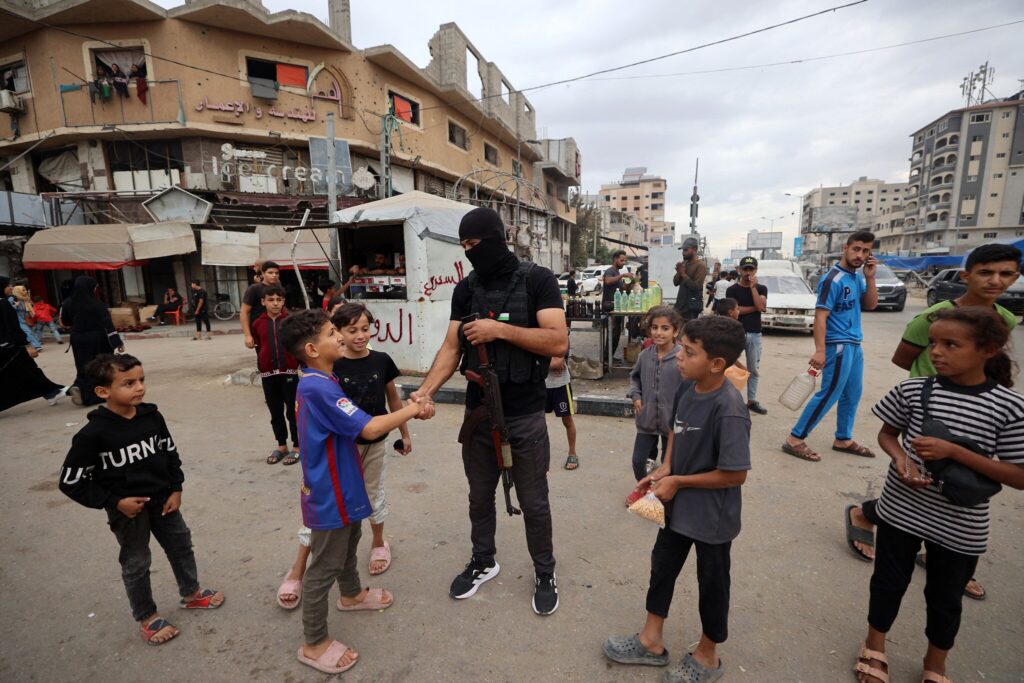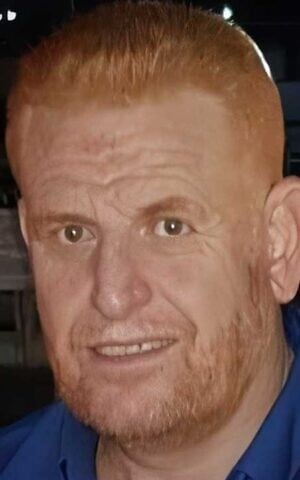NepalIsrael.com auto goggle feed
As Iyad Abu Ramadan, head of the Chamber of Commerce in Gaza City, arrived at his office on Monday morning, he saw a group of masked, armed men in civilian clothing standing at an intersection outside.
He is sure they were Hamas operatives, he said in a phone interview with The Times of Israel. “There is no other armed force that could be there,” he said. “The de facto authority is Hamas.”
Mohammad, who lives in the Nuseirat refugee camp in central Gaza, also reported seeing gunmen deployed at junctions in recent days. “You can see two or three at the [various] crossroads, masked,” he told The Times of Israel by phone.
At night, he said, things turn violent.
Mohammad, whose name has been changed for his safety, said he was aware of several recent killings of civilians by Hamas. Residents learn each morning about what has happened overnight via local Telegram channels or word of mouth in the camp, he said.
Hamas does not announce these actions on its official social media accounts. But every few days since the ceasefire began and the Israel Defense Forces partially withdrew, Telegram channels linked to Hamas have been publishing footage showing violence against Gaza residents — people being shot in the legs or hit with stone blocks in ostensible punishment for alleged crimes including stealing aid, using drugs and collaborating with Israel.
“The situation is frightening,” Mohammad said. “From the moment the ceasefire began [on October 10], we started seeing random killings. It sows fear among Gaza residents, and sadly it’s still going on. There are gunmen who will kill you for alleged collaboration, or for reasons you don’t even know.”
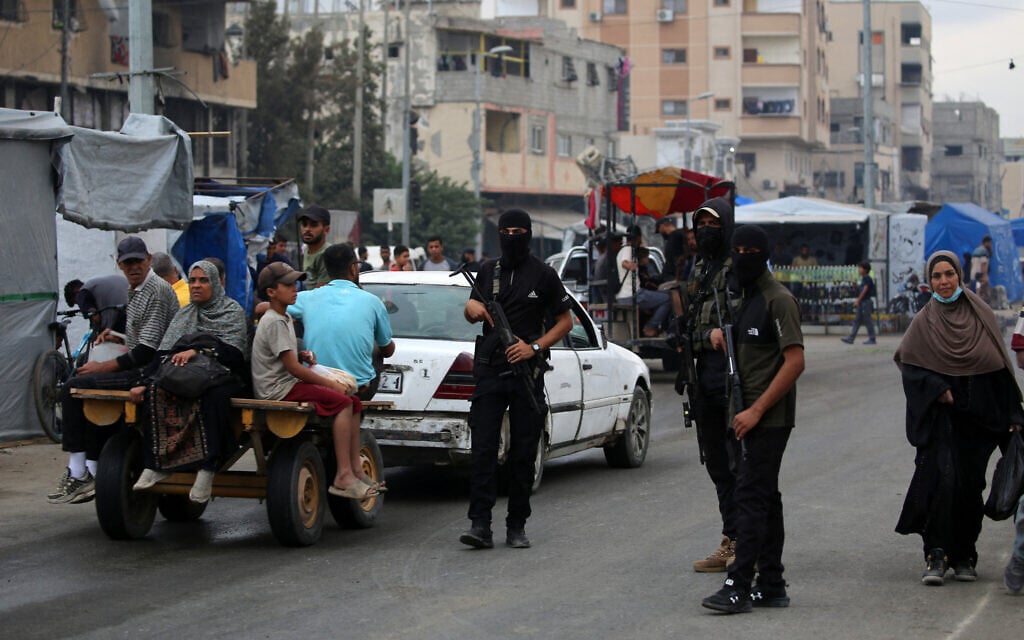
Members of the internal security forces loyal to Hamas are deployed in the Nuseirat refugee camp in the central Gaza Strip, October 12, 2025. (Eyad BABA / AFP)
On Saturday, the al-Saftawi family announced that Hisham al-Saftawi had been shot dead in his home in Nuseirat by Hamas gunmen. Mohammad confirmed the account and said the shooting occurred at 5 a.m., and that al-Saftawi was killed in front of his children. “They didn’t give an excuse,” he said, referring to Hamas.
He described al-Saftawi as a well-known figure in the camp. The family said it would not set up a mourning tent until it had avenged his death at Hamas’s hands.
Officially, Hamas police announced they would investigate the incident, but media outlets aligned with the terror group cited alleged unspecified criminal activity and said al-Saftawi had served in the Palestinian Authority security services when the Palestinian Authority, or rather the Fatah faction headed by its President Mahmoud Abbas, ruled the Strip between 2005 and the violent Hamas takeover in 2007.
The family’s public denunciation of Hamas was unusual; other families that have encountered Hamas violence and murder are generally far too terrified to speak out.
Ahmed Fouad Alkhatib’s brother lives in southern Gaza. On Sunday, this brother told the US-based Alkhatib that he was driving home when he found himself surrounded by masked Hamas gunmen who brandished weapons, checked his car and his ID, and only allowed him to continue after a thorough search.
Alkhatib, who has lived in the US for the past two decades and is a senior fellow at the Atlantic Council, said his brother is afraid to speak to the press himself, but he relayed his brother’s account. “He said to me, ‘These guys are acting like a militia. Why would masked gunmen in civilian clothes surround my car, pull out their guns, and go through the whole car? Why do they have AK-47s? This is not exactly civil’.”
That account reflects the nature of Hamas’s activity in the Strip these days: operating as a deadly militia against those it perceives as threats, while avoiding overt full governance.
Besieged by Hamas gunmen ‘with mortars and RPGs’
At least two public incidents of multiple executions were filmed on October 13 and subsequently acknowledged by Hamas-affiliated media. The footage provoked an uproar online and increasing anger from US President Donald Trump, who is adamant that Hamas must and will disarm. It was also followed by a warning from the US State Department that Hamas was planning further attacks against the people of Gaza, and that these attacks would constitute “a direct and grave violation of the ceasefire agreement.”
Gazan residents interviewed by The Times of Israel said those cases of multiple executions were largely confined to Gaza City, and have not been repeated in recent days.
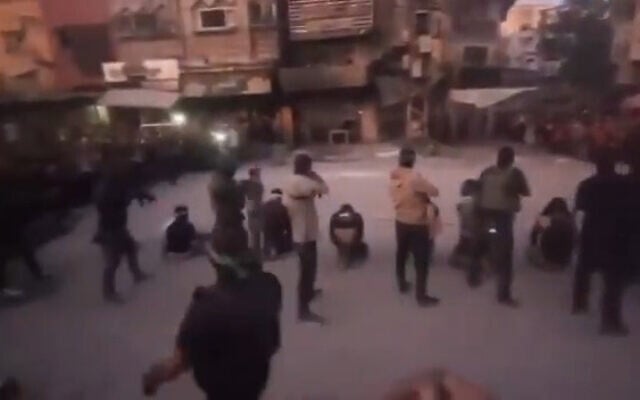
Palestinians accused of collaboration with Israel are seen blindfolded moments before their execution by Hamas gunmen in a Gaza street, October 13, 2025 (Screenshot: X)
Some locals partially justified Hamas’s actions. Omar, a Gaza City resident who asked not to be identified by his real name, said: “The (Hamas) police are deployed so that no one can steal aid; they are securing the aid. The executions were of people who worked with (anti-Hamas militias), people who stole and sold the aid. And some of them were collaborators with the occupation (referring to Israel).”
Salah (also a pseudonym), who lives in central Gaza, said he does not support Hamas but added: “Hamas arrests people who are wanted for all sorts of things. The killing phenomenon has stopped,” he claimed. “They settled scores with some families that did bad things to people — that set up checkpoints to steal, confiscate weapons and generally intimidate,” he said. Those people “did many bad things. These are criminals; they need to be eliminated. That is my personal opinion.”
“Hamas operatives are on the ground and naturally they’ll rule,” said Salah. He claimed most Gazans don’t want Hamas rule, “but feel there is a vacuum; there is no one to enter and replace them.”
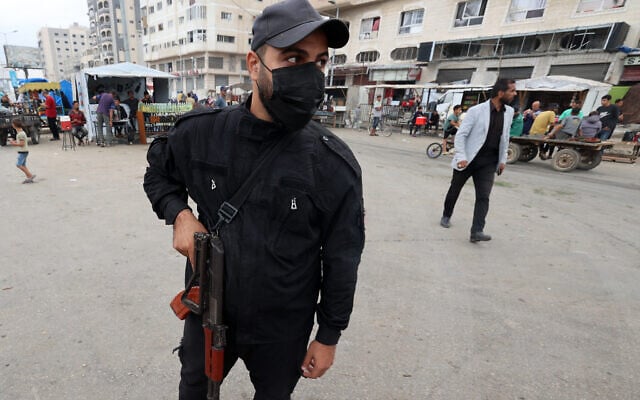
A member of the internal security forces loyal to the Palestinian terror group Hamas mans a checkpoint in the Nuseirat refugee camp in the central Gaza Strip, on October 12, 2025. (Photo by Eyad BABA / AFP)
The US-based Ahmed Fouad Alkhatib, who is in daily contact with his extended family in Gaza, explained that there is indeed “a vacuum” in Gaza, “in the sense that there isn’t a ready alternative to Hamas. The only ones that were really potentially willing to fill that gap are people with guns. Who has guns in Gaza? It’s either the clans (the big families in the Strip), or the militias that worked with Israel.” Now, with the IDF having withdrawn to an area that covers barely half of Gaza, Hamas has been settling scores with those rivals.
Before the ceasefire, three main militias were operating in Gaza — led by Ashraf al-Mansi in the north, Hossam al-Astal in Khan Younis, and Yasser Abu Shabaab in eastern Rafah.
The latter two have acknowledged receiving military and logistical support from Israel; the al-Mansi militia has not, but a senior figure in the Abu Shabab militia told The Times of Israel that al-Mansi’s group operates in similar fashion.
Since the ceasefire began, Gaza media has reported multiple Hamas clashes with al-Mansi’s militia and other clans in Gaza City. The two other groups are based in areas that are either still under IDF control or very close to IDF deployments.
“In the 50% or so that Hamas controls, the terror group has taken every opportunity it has had to go after anybody with weapons. It has also ‘mixed’ the two separate files — of crime and lawlessness, on the one hand, with, on the other, accusations, fake or exaggerated or real, of collaboration with Israel,” Alkhatib explained.
That mixing, Alkhatib said, makes it easier for Hamas to legitimize its punitive actions.
The names of those who have been killed, including in the public executions, have not been published officially, but Gaza media reports say many were from the large Dormoush family in Gaza City. Previously during the war, Israel reportedly offered members of the family a deal to cooperate against Hamas, which they refused.
One family elder, Nizal Dormoush, told the Saudi Al-Arabiya TV channel in a phone interview on Saturday that Hamas gunmen had killed 33 members of his family. He said the area in Gaza City where his family lives was besieged by a large number of Hamas operatives “with mortars and RPGs.”
He denied allegations of collaboration with Israel, but also said that if some family members did collaborate with Israel, they should be handed over to legal authorities — effectively recognizing the legitimacy of pursuing and punishing collaborators, though not the capital punishments.
‘A death cult engaged in a massive human sacrifice’
Those speaking publicly in recent days about Hamas’s actions tend to be influential local figures, established families and elders. As Mohammad acknowledged, there is tremendous fear among Gazans about speaking out against Hamas since the ceasefire began.
“Many people started to reduce (their online presence) and don’t want to speak because of fear of the repercussions. This situation, of Hamas, militias and gangs, is not stable at all,” Mohammad said.
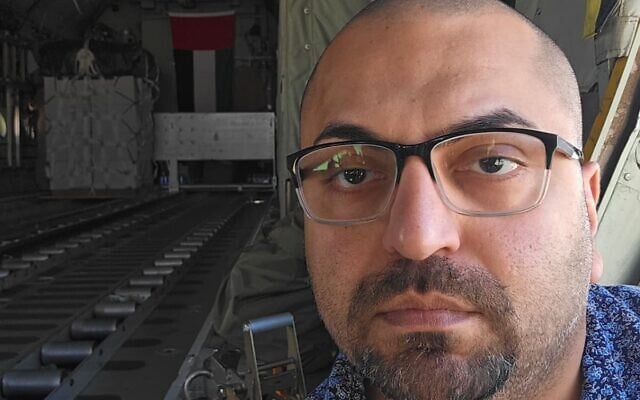
Ahmed Fouad Alkhatib aboard an aircraft preparing to airdrop aid into Gaza, August 25, 2025 (courtesy).
Alkhatib said he senses the change even in private calls with family and friends: people felt more comfortable talking about Hamas during the war than now, during the ceasefire. “Because Hamas was underground, there was less of a chance of them coming after people.” Today, by contrast, even saying, ‘That’s what I saw, that’s what I encountered,’ it’s a risk right now. Everybody’s lowering” their profile.
The big question, of course, is how current events in Gaza, and especially the reemergence of Hamas, will shape the Strip’s future. Trump’s 20-point peace plan for Gaza requires the disarmament of Hamas and the demilitarization of the Strip. Hamas officials have indicated they will not give up their weapons. The hostage-ceasefire agreement signed by Israel and Hamas on October 9 does not cover the issue of postwar governance, which has yet to be negotiated.
Gazans interviewed by The Times of Israel offered divergent forecasts: some expect Hamas to resume its rule, others foresee Arab or international forces arriving in the coming months and displacing it.
Chamber of Commerce head Abu Ramadan said his primary fear is Israel, which he said views all Gaza residents as the enemy. “Israel demands security and peace but no one is demanding peace and security for us. Israel is still an occupying force in the Strip, and most of Israeli society thinks Gaza is the enemy and all its residents are enemies, and it would be better if Gaza disappeared.”
Nonetheless, he said that if Hamas retains power, “there will be no rehabilitation of Gaza, and that’s a very difficult issue for Gaza residents. And there will be no possibility to achieve peace.”
Alkhatib offered a bleak near-term forecast for Gaza under a militia-style Hamas presence: “It is going to be very grim. It will take three to five years, at minimum, to just stabilize things.
“I think it’s going to take a biblical miracle to try to really, truly transform that place,” he went on. “Not because it cannot be done, but because you have a [Hamas] death cult that is engaged in a massive human sacrifice and is holding two million people hostage. We got 20 Israeli living hostages out. Wonderful. But now we have two million Palestinian hostages.”
The post”The return of Hamas: With wave of executions, terror group reasserts control in Gaza” is auto generated by Nepalisrael.com’s Auto feed for the information purpose. [/gpt3]



